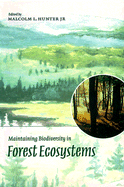2 - Principles of ecological forestry
Published online by Cambridge University Press: 20 February 2010
Summary
Ecologically sound stewardship has long been a cornerstone of the forestry profession. But just what does ‘ecologically sound’ mean in practice? Historically, foresters were often taught that forest ecosystems could be engineered at will for human benefit. Ensuring ecological integrity meant not violating ‘constraints’ associated with soil, water quality, and wildlife (implicitly defined as well-known birds and mammals). Recently, the definition of ecological integrity has expanded; clearly, a primary focus is now on maintaining, and even restoring, native biological diversity. At the same time, a growing worldwide demand for forest products has encouraged foresters to expand traditional high-yield practices, amidst growing evidence that such systems often conflict with biodiversity.
While not discounting the difficulty of these conflicts, we believe there is a vision of ecological forestry that offers hope. To set the stage for the rest of this book, we define ecosystems, stands, and landscapes. Next, we review various incarnations of forestry, with emphasis on North American practice and the strong influence of the U.S. Forest Service. Hopefully, this will help readers to place the current discussion of ecological forestry into an historical, scientific, and professional context. Important principles of ecological forestry are defined and discussed, and related to traditional timber production forestry. Finally, a balanced forestry paradigm, which blends elements of traditional and ecological forestry, is described.
Ecosystems, stands, and landscapes
Asked to define ecosystem, a politician who was espousing the importance of protecting ecosystems hesitated for a long time then finally said, ‘Well … they're kind of like an aquarium … they have plants and animals … and other stuff.’ In fairness to the politician, ecosystems can be rather hard to define.
- Type
- Chapter
- Information
- Maintaining Biodiversity in Forest Ecosystems , pp. 22 - 62Publisher: Cambridge University PressPrint publication year: 1999
- 109
- Cited by

